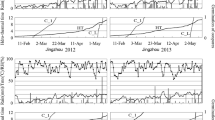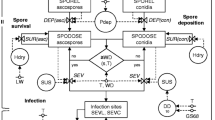Abstract
Black rot on grapevine is a fungal disease caused by Phyllosticta ampelicida (syn. Guignardia bidwellii) affecting grape leaves as well as clusters. A novel black rot decision support system termed VitiMeteo Black rot was assembled based on existing sub-models and incorporated into the established VitiMeteo forecast and decision support platform. Based on local weather data and a 5-day weather forecast, VitiMeteo Black rot simulates the relative susceptibility of grape clusters, the occurrence and severity of infection events as well as the duration of incubation periods. Data sets obtained in extended international (14 case studies; eight monitoring locations; 11 cultivars; seven countries in Europe and North America) field monitoring campaigns in 2012 and 2013 were used to evaluate the model predictions of newly expressed symptoms on leaves. In the case of the Vitis vinifera cultivars, on average 26.3 disease assessments took place per season. On average, 9.9 predictions were classified as true positive, 8.0 as true negative, 5.2 as false positive and 3.2 as false negative. Model precision, sensitivity and accuracy were on average 64, 77 and 67 %. Potential reasons for false positive and false negative predictions are discussed. VitiMeteo Black rot is freely available for several locations in Germany, Luxembourg and Austria on the internet via the VitiMeteo platform and might be expanded to other regions in the future.


Similar content being viewed by others
References
Bleyer, G., Kassemeyer, H.-H., Krause, R., Viret, O., & Siegfried, W. (2008). „VitiMeteo Plasmopara“ - Prognosemodell zur Bekämpfung von Plasmopara viticola (Rebenperonospora) im Weinbau. Gesunde Pflanze, 60, 91–100.
Bleyer, G., Kassmeyer, H. H., Breuer, M., Krause, R., Viret, O., Dubuis, P.-H., Fabre, A., Bloesch, B., Siegfried, W., Naef, A., & Huber, M. (2011). “VitiMeteo” – a future-oriented forecasting system for viticulture. IOBC/wprs Bulletin, 67, 69–77.
Caffarra, A., & Eccel, E. (2009). Increasing the robustness of phenological models for Vitis vinifera cv. Chardonnay. International Journal of Biometeorology, 54(3), 255–267.
Caffi, T., Rossi, V., Legler, S. E., & Bugiani, R. (2011). A mechanistic model simulating ascosporic infections by Erysiphe necator, the powdery mildew fungus of grapevine. Plant Pathology, 60, 522–531.
Ellis, M. A., Madden, L. V., & Wilson, L. L. (1986). Electronic grape black rot predictor for scheduling fungicides with curative activity. Plant Disease, 70(10), 938–940.
Ferrin, D. M., & Ramsdell, D. C. (1978). Influence of conidia dispersal and environment on infection of grape by Guignardia bidwellii. Phytopathology, 68(6), 892–895.
Ficke, A., Gadoury, D. M., & Seem, R. C. (2002). Ontogenic resistance and plant disease management: a case study of grape powdery mildew. Phytopathology, 92(6), 671–675.
Harms, M., Holz, B., Hoffmann, P.G., Lipps, H.P., & Silvanus W. (2005). Occurrence of Guignardia bidwellii, the causal fungus of black rot on grapevine, in the vine growing areas of Rhineland-Palatinate, Germany. BCPC symposium proceedings, No. 81, 127–132.
Hoffman, L. E., Wilcox, W. F., Gadoury, D. M., & Seem, R. C. (2002). Influence of grape berry age on susceptibility to Guignardia bidwellii and its incubation period length. Phytopathology, 92(10), 1068–1076.
Hoffman, L. E., Wilcox, W. F., Gadoury, D. M., Seem, R. C., & Riegel, D. G. (2004). Integrated control of grape black rot: influence of host phenology, inoculum availability, sanitation, and spray timing. Phytopathology, 94(6), 641–650.
Kuo, K. C., & Hoch, H. C. (1996). The parasitic relationship between Phyllosticta ampelicida and Vitis vinifera. Mycologia, 88(4), 626–634.
Lorenz, D. H., Eichhorn, K. W., Bleiholder, H., Klose, R., Meier, U., & Weber, E. (1995). Phenological growth stages of the grapevine, Vitis vinifera L. ssp. vinifera. Codes and descriptions according to the extended BBCH scale. Australian Journal of Grape and Wine Research, 1(2), 100–103.
Loskill, B., Molitor, D., Koch, E., Harms, M., Berkelmann-Löhnertz, B., Hoffmann, C., Kortekamp, A., Porten, M., Louis, F., & Maixner, M. (2009). Strategien zur Regulation der Schwarzfäule (Guignardia bidwellii) im ökologischen Weinbau – Management of Black rot (Guignardia bidwellii) in organic viticulture. Final project report submitted to the German Federal Ministry of Nutrition, Agriculture and Costumer protection. Online access: http://orgprints.org/17072/1/17072-04OE032-jki-maixner-2009-schwarzfaeule.pdf. Accessed 04 June 2015.
Molitor, D. (2009). Biologie und Bekämpfung der Schwarzfäule (Guignardia bidwellii) an Weinreben. Dissertation, Geisenheimer Berichte Bd. 65. Gesellschaft zur Förderung der Forschungsanstalt Geisenheim, Geisenheim.
Molitor, D., & Berkelmann-Löhnertz, B. (2011). Simulating the susceptibility of clusters to grape black rot infections depending on their phenological development. Crop Protection, 30(12), 1649–1654.
Molitor, D., & Beyer, M. (2014). Epidemiology, identification and disease management of grape black rot and potentially useful metabolites of black rot pathogens for industrial applications - a review. Annals of Applied Biology, 165, 305–317.
Molitor, D., Baus, O., & Berkelmann-Löhnertz, B. (2011). Protective and curative grape black rot control potential of pyraclostrobin and myclobutanil. Journal of Plant Diseases and Protection, 118(5), 161–167.
Molitor, D., Fruehauf, C., Baus, O., & Berkelmann-Löhnertz, B. (2012). A cumulative degree-day-based model to calculate the duration of the incubation period of Guignardia bidwellii. Plant Disease, 96(7), 1054–1059.
Molitor, D., Caffarra, A., Sinigoj, P., Pertot, I., Hoffmann, L., & Junk, J. (2014a). Late frost damage risk for viticulture under future climate conditions: a case study for the Luxembourgish winegrowing region. Australian Journal of Grape and Wine Research, 20(1), 160–168.
Molitor, D., Junk, J., Evers, D., Hoffmann, L., & Beyer, M. (2014b). A high resolution cumulative degree day based model to simulate the phenological development of grapevine. American Journal of Enology and Viticulture, 65(1), 72–80.
Nendel, C. (2010). Grapevine bud break prediction for cool winter climates. International Journal of Biometeorology, 54(3), 231–241.
Northover, P.R. (2008). Factors influencing the infection of cultivated grape (Vits spp. Section Euvitis) shoot tissue by Guignardia bidwellii (Ellis) Viala & Ravaz. Dissertation. The Pennsylvania State University.
Rinaldi, P., Broggini, G.A.L., Gessler, C., Molitor, D., Sofia, J., & Mugnai, L. (2013a). Guignardia bidwellii, the agent of grape black rot of grapevine, is spreading in European vineyards. 10th International Congress of Plant Pathology (ICPP 2013). Book of abstracts, 211.
Rinaldi, P., Skaventzou, M., Rossi, M., Comparini, C., Sofia, J., Molitor, D., & Mugnai, L. (2013b). Guignardia bidwellii: Epidemiology and symptoms development in Mediterranean environment. Journal of Plant Pathology, 95(1., Supplement), S1.83–S1.84.
Rossi, V., Caffi, T., Giosuè, S., & Bugiani, R. (2008). A mechanistic model simulating primary infections of downy mildew in grapevine. Ecological Modelling, 212, 480–491.
Rossi, V., Onesti, G., Legler, S. E., & Caffi, T. (2014). Use of systems analysis to develop plant disease models based on literature data: grape black-rot as a case-study. European Journal of Plant Pathology, 141, 427–444.
Schultz, H. R. (1992). An empirical model for the simulation of leaf appearance and leaf-area development of primary shoots of several grapevine (Vitis vinifera L) canopy-systems. Scientia Horticulturae, 52(3), 179–200.
Smith, D. L., & Sutherland, A. (2010). The new agweather black rot advisor and how to use it. Le Vigneron, 5(3), 5–7.
Spotts, R. A. (1977). Effect of leaf wetness duration and temperature on infectivity of Guignardia bidwellii on grape leaves. Phytopathology, 67(11), 1378–1381.
Spotts, R. A. (1980). Infection of grape by Guignardia bidwellii - factors affecting lesion development, conidial dispersal, and conidial populations on leaves. Phytopathology, 70(3), 252–255.
Trudgill, D. L., Honek, A., Li, D., & Van Straalen, N. M. (2005). Thermal time - concepts and utility. Annals of Applied Biology, 146, 1–14.
Viala, P., & Ravaz, L. (1886). Mémoire sur une nouvelle maladie de la vigne, le Black Rot (pourriture noir). Annales de l’École National d’Agriculture de Montpellier, 2, 17–58.
Acknowledgments
The authors wish to thank S. Fischer and R. Mannes (Institut Viti-vinicole (IVV), Remich, Luxembourg) for providing experimental vineyards, M. Skaventzou (University of Florence, Italy), N. Baron, M. Pallez, L. Giustarini (LIST, Belvaux, Luxembourg), C. Rieger, P. Erhardt and M. Grundler (Staatliches Weinbauinstitut Freiburg, Germany), L. Torriani (Agroscope Cadenazzo, Switzerland), S. Garidel (IVV Remich, Luxembourg) for technical assistance in the field monitoring as well as in GIS, B. Berkelmann-Löhnertz (Geisenheim University, Germany), G.K. Hill (DLR Rheinhessen-Nahe-Hunsrück, Oppenheim, Germany), O. Viret (Agroscope Changins, Switzerland), H.-H. Kassemeyer (Staatliches Weinbauinstitut Freiburg, Germany) and R. Krause (Geosens Ingenieurpartnerschaft, Ebringen, Germany) for supporting the development and implementation of the model as well as the Institut Viti-viticole (Remich, Luxembourg) for financial support in the framework of the research project „ProVino – Pesticide reduction in viticulture“.
Author information
Authors and Affiliations
Corresponding author
Rights and permissions
About this article
Cite this article
Molitor, D., Augenstein, B., Mugnai, L. et al. Composition and evaluation of a novel web-based decision support system for grape black rot control. Eur J Plant Pathol 144, 785–798 (2016). https://doi.org/10.1007/s10658-015-0835-0
Accepted:
Published:
Issue Date:
DOI: https://doi.org/10.1007/s10658-015-0835-0




